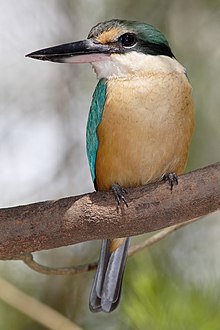Todiramphus sanctus
| Sacred kingfisher | |
|---|---|
 |
|
| Sacred kingfisher (male) (Todiramphus sanctus) |
|
| Scientific classification | |
| Kingdom: | Animalia |
| Phylum: | Chordata |
| Class: | Aves |
| Order: | Coraciiformes |
| Family: | Alcedinidae |
| Subfamily: | Halcyoninae |
| Genus: | Todiramphus |
| Species: | T. sanctus |
| Binomial name | |
|
Todiramphus sanctus (Vigors & Horsfield, 1827) |
|
| Synonyms | |
|
Halcyon sancta |
|
Halcyon sancta
The sacred kingfisher (Todiramphus sanctus) is a medium-sized woodland kingfisher that occurs in mangroves, woodlands, forests, and river valleys in Australia, New Zealand, and other parts of the western Pacific. In New Zealand the species is also known by its Māori name kōtare.
It is called “sacred” for it was said to be a holy bird for Polynesians, who believed it to have control over the waves. Likewise, the local subspecies of collared kingfisher and other kingfishers in the southwestern Pacific were ascribed venerable power over the ocean.
The sacred kingfisher was described by the naturalists Nicholas Aylward Vigors and Thomas Horsfield in 1827 under the binomial name Halcyon sanctus.Halcyon is feminine and the correct name would be Halcyon sancta. Vigors and Horsfield compare their species to Alcedo sacra described by Johann Friedrich Gmelin in 1788. Gmelin in turn based his description on John Latham's "Sacred King's Fisher" published in 1782. Latham described several varieties, one of which was illustrated in Arthur Phillip's The Voyage of Governor Phillip to Botany Bay published in 1789. The genus Halcyon is now split and the sacred kingfisher placed in the genus Todiramphus that had been erected by the French surgeon and naturalist René Lesson in 1827.
Five subspecies are recognised:
Sacred kingfishers are found in Australia, New Zealand, Lord Howe Island, Norfolk Island, New Guinea, eastern Indonesia, much of northern and western Melanesia, and the Kermadec Islands. This species breeds throughout much of Australia (except the dry interior), New Zealand, New Caledonia and locally, New Guinea. Populations in the southern two-thirds of Australia migrate northwards at the end of breeding season to New Guinea, east to the eastern Solomon Islands and west to Indonesia becoming uncommon to very sparse as west as Sumatra. Birds move south again to Australia in August to September. It has also occurred as a vagrant on Christmas Island (in the Indian Ocean),Malaysia, the Marshall Islands, the Federated States of Micronesia, and Nauru. A pair spotted in Pampanga Philippines April / May 2016.
...
Wikipedia

